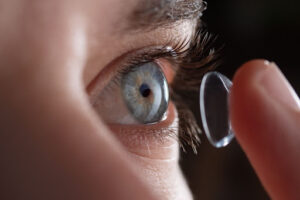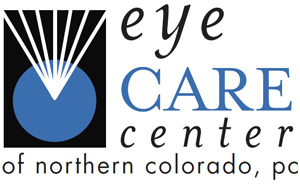Your cornea is delicate and vital for clear sight. The cornea, the clear front portion of your eye which covers your iris and pupil, is responsible for focusing the light that enters your eye. If your cornea is unhealthy, your vision is affected.
Corneal ulcers (keratitis) are open sores on the cornea. They can be caused by many things, but for the purposes of this blog, we will focus on the infections leading to corneal ulcers that can be caused or exacerbated by contact lens wear. 
These include:
- Bacterial infections
- Fungal infections
- Parasitic infections
Symptoms of a Corneal Ulcer
Corneal ulcers can “permanently damage your vision and even cause blindness if they are not treated,” says the American Academy of Ophthalmology. If you are experiencing any of the symptoms listed below you might have a corneal ulcer. Call your local eye care center for an appointment immediately.
- White spot on your cornea
- Severe pain and soreness of the eye
- Swelling of the eyelids
- Feeling like something is in your eye
- Redness of the eye
- Tearing or discharge
- Sensitivity to light
- Blurry vision
Types of Corneal Ulcers
In addition to the three infections we address here, you can develop a corneal ulcer from a viral infection, abrasions, burns, or injuries to the eye, dry eye syndrome, or complications due to Bell’s Palsy.
For our purposes, we will discuss the most common corneal ulcers related to contact lens wear.
Bacterial Corneal Ulcers
A common infection contracted by contact lens wearers, especially those who wear extended-use lenses, is caused by bacteria in the eye. Overnight wear and improper contact lens disinfection can lead to infection, which can result in an ulcer. A bacterial infection is transmittable.
Fungal Corneal Ulcers
Fungi that exist in the environment or on the skin can wind up in the eye because of improper handling of contact lenses, causing a fungal infection. The infection can result in an ulcer. Fungal infections are not typically contagious.
Parasitic (Acanthamoeba) Corneal Ulcers
Acanthamoeba is most often found in fresh water and soil and can cause an infection when they come in direct contact with the eye. Most commonly, the infection affects those with soft contact lenses. The parasite makes its way into the cornea through tiny abrasions caused by ineffective contact lens care. It is not contagious.
Diagnosis of Corneal Ulcer
To diagnose a corneal ulcer, your eye doctor will use a fluorescein dye to illuminate damage to your cornea. If there is damage, they will use a slit-lamp microscope to examine the damage and determine whether it is ulcerous. They may need to take a tissue sample to establish the best line of treatment.
Treatment for Corneal Ulcers
Antibiotic, antifungal, and antiseptic eye drops are often used to treat corneal ulcers. In some cases, an injection of medication may be necessary. If there is significant scarring as a result of your ulcer or your ulcer doesn’t respond to medication, you may need a corneal transplant to improve or save your vision.
The American Academy of Ophthalmology recommends that if your “symptoms suddenly change or get worse during treatment” you contact your eye doctor immediately.
Contact lens non-hygienic habits that cause/aggravate corneal ulcers
Habits that can cause infection and later corneal ulcers are:
- Cleaning contacts with tap water
- Swimming, showering, or hot tub use while wearing contacts
- Sleeping in your contacts
- Using extended-wear contact lenses
- Not keeping your contact lens case clean
How to avoid corneal ulcers caused by contact lens wear
- Always wash your hands and avoid touching or rubbing your eyes
- Clean your contacts properly
- Wash your hands first
- Use sterile, store-bought solution
- Place a contact lens in your palm with solution and rub (even if it is “no-rub” solution) for 20 seconds on each side
- Rinse the contact lenses for 10 seconds on each side
- Put contacts into a clean, dry case
- Fill the case with fresh solution
- Repeat with the second contact
- Don’t swim, shower, or use a hot tub with your contacts in
- Replace your contact case regularly and keep it clean and dry
- Take breaks from wearing your contacts to give your eyes time to heal from irritation
- Never sleep in your contacts
- Replace contacts as directed by your eye doctor
- Never use someone else’s contacts or case
- Keep up with regular eye exams at your local eye center
And if you are exhibiting any symptoms of a corneal ulcer, make an appointment with your eye doctor immediately.
Eye Care Center of Northern Colorado has eye doctors committed to exceeding all your eye care needs. We have Greeley, Lafayette, Longmont, and Boulder Eye Care Center locations, call today to schedule your eye exam with the local office of your choosing.
For more information on eye care, take a look at our blogs on Common Corneal Disorders and Preventative Eye Care.
Resources and References:
https://www.aao.org/eye-health/diseases/contact-lens-related-eye-infections
https://www.aao.org/eye-health/diseases/corneal-ulcer
https://www.aao.org/eye-health/diseases/herpes-keratitis
https://www.aao.org/eye-health/diseases/what-is-corneal-abrasion

